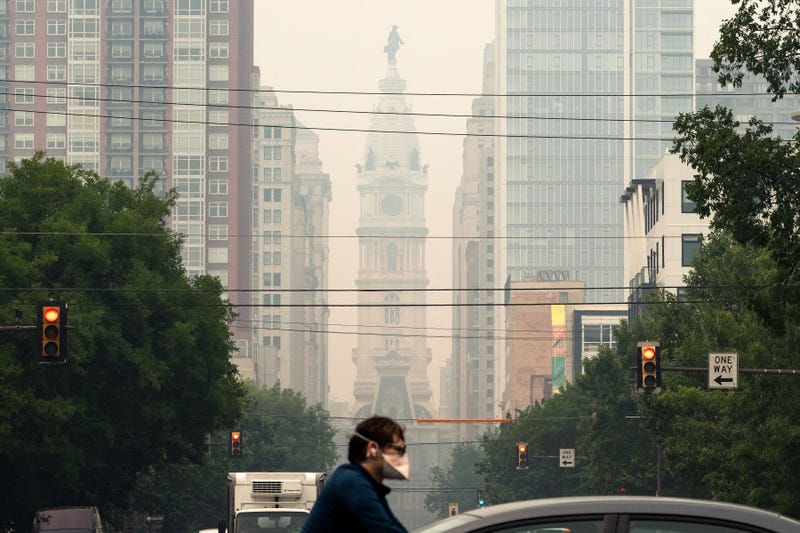
PHILADELPHIA (KYW Newsradio) — The smoke has started to clear, making way for healthier air after “hazardous” conditions plagued the region.
Smoke carried on the wind from intense Canadian wildfires had blanketed the northeastern U.S. in a dystopian haze, prompting warnings for vulnerable populations to stay inside.
Although an air quality alert is still in effect in Philadelphia, the air reached a level that is considered "moderate" late Friday morning, according to the federal agency AirNow, a welcome reprieve from conditions just 24 hours prior.
However, people with heart or lung issues and other sensitive groups should still be cautious. Health officials recommend those individuals reduce their activity levels and stay indoors while the haze clears.
While Philly schools were learning remotely, all city services resumed Friday. Philadelphia Parks and Rec got the OK to continue with outdoor programming and events.
Trash and recycling pickup is back underway. Crews will work through Saturday to make sure they are caught up on the collections for the week.
Air Quality Index
The scale of particulate matter in the air ranges from zero to 500. The higher the number, the worse the air quality.
Thursday morning saw the worst of it, with an Air Quality Index (AQI) in our region between 350 and 450. An AQI of 201 to 300 is considered “very unhealthy,” 151 to 200 is “unhealthy,” and 101 to 150 is “unhealthy for sensitive groups.”
An AQI of 51 to 100 is considered moderate, while zero to 50 has no health impacts.
The conditions are expected to dissipate slowly into the weekend.
Find out how your region is affected here.
Current AQI in Philadelphia
What caused the haziness?
“There's a bunch of things in smoke, among them lots of particulate matter,” explained Dr. Ezra Wood, an atmospheric chemist and a Drexel University professor of chemistry. “So small little particles, aerosol particles suspended in the air. And so one way of measuring them is this what's the total mass within a certain volume. So you measure that and micrograms per cubic meter of air.”
Wood said these particles in the air are what cause the city skyline to look hazy.
“This has to do with the optical properties of these small particles. If you shine light from point A to point B, and there's particles in between that are going to scatter or absorb some of that light, then that's going to affect the visibility.
“If you look across the horizon, if you see City Hall from far away, you're seeing light which has reflected off City Hall and it's coming toward your eyes. So if that light coming toward your eyes now gets scattered away from you by all those tiny particles in the air, you're not going to be able to see City Hall very well.”
Climate change
Climate scientists have predicted extreme weather events, including hazardous air quality from forest fires that happen as a result of rising global temperatures.
Climate change refers to the long-term shifts in weather patterns. This is the realm of expertise of Dr. Samantha Chapman. She’s an ecosystem biologist and professor of biology at Villanova University. She's been studying climate change for more than a decade.
Chapman said global temperatures have risen 1.2 degrees Celsius since industrialization due to the emission of heat-trapping gasses.
"The sea levels are higher because thermal expansion is happening to the water,” she explained. “The forests can be drier because there's not as much rain because the rain patterns have shifted. The floods can be more intense because there's more water in the ocean or in the rainstorms, which then enter into systems."
Now globally, the goal is to reverse course, so that the temperature doesn't increase beyond 1.5 or 2 degrees Celsius. She said there are still a few years before we hit a tipping point. But as temperatures rise, she said weather events will continue to get more extreme.
Dr. Chapman said what’s been fascinating in her career is that scientists like herself have been predicting these kinds of extreme weather events we’re seeing now.
"What's been crazy over the course of my career is, I've been in the time where we knew that, started studying it, and now we're actually seeing those effects take hold in the Earth's system. And so that's been a pretty crazy ride."
She said we should get used to seeing weather events that our region hasn’t seen before.
“An example in the Philadelphia area is when we had the large floods that flooded I-676. That was an extreme rain event. This is an extreme drought event that's causing more fires. So yes, the extremes in our climate system are likely to be more common.”
